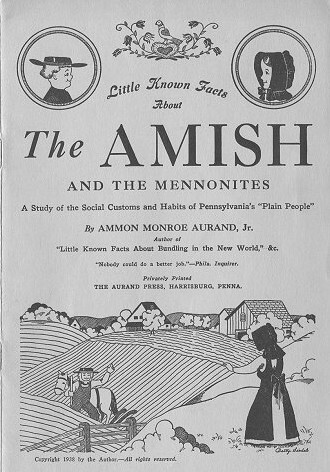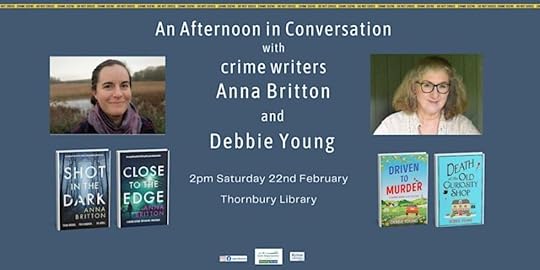Debbie Young's Blog, page 3
February 26, 2025
In Conversation with Liza Perrat, Historical Novelist
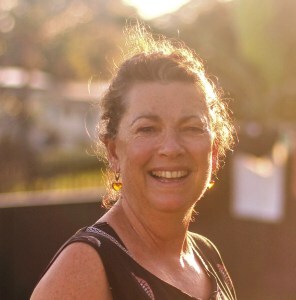 Meet Liza Perrat!
Meet Liza Perrat!In last month’s In Conversation post, Scottish author Lorna Fergusson and I discussed writing about a sense of place, with particular focus on Lorna’s latest book, One Morning in Provence, in which the lives of British characters are changed by trips to France.
This month, I’m talking about books set in France again, this time with Australian author Liza Perrat, and with a different perspective. In Liza’s France-based books, the characters are French, and the reader is immersed in French life and culture from down the ages.
So how did an Australian come to write such convincing novels set in another country? In her younger days, Liza would have been surprised about this too! Over to Liza…
Liza: First of all, many thanks to Debbie for having me as a guest. I really admire your writing, Debbie, and it’s an honour to appear on her blog.
I’m an Aussie-born girl and grew up on the stunning New South Wales coast, never imagining I’d live anywhere else. Fast forward 28 years and I was in for a big surprise!
Back in 1988, working as a general nurse and midwife, I secured a midwifery job in Saudi Arabia, and decided to spend three months beforehand visiting Thailand, Nepal and India.
Meeting someone certainly did not feature on my list of holiday “to-do” list but, as fate would have it, on my first day in Bangkok I met a Frenchman.
37 years later, we are still (mostly!) happily married.
We settled in France, and my entire life abruptly changed in every possible way, and I must say it was a bit of a struggle to adapt to French life. I missed my Aussie friends and family and the beautiful beaches terribly for many years, but fortunately I was too busy with three young children to have the time or energy to dwell on homesickness.
Then, unannounced, creative writing popped into my life, and saved me from myself.
I’d always been a history buff and voilà, I was now living amidst all of this amazing European history. After obtaining a degree in French, I found myself (with real conscious decision), writing historical fiction. Of course, I often got lost down the rabbit warrens of research and my French historical trilogy, The Bone Angel, took far longer to write than it should have.

I based my fictional village for the three books on the rural French village in which I live.
Debbie: My home village in the Cotswolds, where I’ve lived since 1991, is also the inspiration for my Sophie Sayers novels, and my new Cotswold Curiosity Shop series. Our books are very different, and it’s interesting to see what different paths we have taken with a similar starting point!
Liza: My village is also the headquarters for the regional historical society (l’Araire). Needless to say, I paid the Araire a lot of visits and they were incredibly helpful with many historical aspects of the village, from the 14th–20th century, encompassing the Black Plague, the French Revolution, and the French Resistance of World War II. Many of the villagers (including a few ex-resistance fighters) were also keen to tell me about their heroic and dangerous tales as they answered General de Gaulle’s call to liberate France from the Nazi occupiers.
This group of small, close-knit villagers are proud of their history, their heritage and their bravery against the many and varied foes across the centuries, and I consider myself very lucky to have had their help in writing my novels.
The Bone Angel trilogy is available as an e-book HERE.
Debbie: What a wonderful resource you have tapped into – no wonder your French historical novels ring true! I bet the villagers are very pleased and proud that you have chronicled their history so faithfully. But you haven’t only written about France, have you?
Liza: No, I’ve also written three Australia-based, coming-of-age novels set in the 70s.

Embracing the social changes of 1970s Australia, against a backdrop of native fauna and flora, The Silent Kookaburra is a haunting exploration of the blessings, curses and tyranny of memory. This unsettling psychological suspense story is available HERE.

Reflecting the social changes of 1970s Australia, The Swooping Magpie is a chilling psychological tale of love, loss and grief, and, through collective memory, finding we are not alone.
The third book, The Lost Blackbird, is the tragic story of child migration based on real events.

Then I returned to French settings, for another historical fiction trilogy, The Women of the Lake. These stories are set more recently, in the late 60s and early 70s, as France teetered on the cusp of women’s liberation and feminism. The first book, Lake of Echoes is an emotional French village tale of a missing child. The second (though all are standalones), Lake of Widows, explores the complexities of marriage, family secrets and self-discovery in 20th-century France.
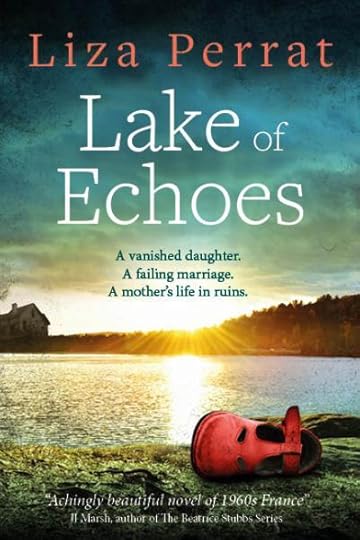
Debbie: This is another fascinating era to write about. Did you have a similar experience of gathering information from friends and neighbours, or did you have to do some other kind of research?
Liza: Once again, family and friends were very helpful in recalling the important beginnings of women’s lib and feminism, and only too keen to talk about it.
Debbie: Clearly your first French trilogy could only have been set in France, due to the historical context. Is the same true of The Women of the Lake? How was that era different for women in France from how it was in other countries?
Liza: I think life was similar for women in France during this time as in other countries of the Western World. Though it seemed the French were highly influenced by events in the USA, such as music and fashion and, notably, the hippie counterculture movement, rejecting what they saw as the staid, old-fashioned mores of traditional French life. As in the USA, some adopted communal living and vegetarian diets, and participated in “peace and love” events like Woodstock. So, to answer your question, I think The Women of the Lake could be set in any Western country, but I wanted to capture the essence of the traditional French culture coming up against the social changes of women’s lib, feminism and equality for both sexes in other parts of the Western World.
Debbie: You clearly love writing trilogies! We all know that readers love series, and trilogies are a bit of a magic number for book series. What is it about trilogies that appeals to you as a writer?
Liza: I never planned to write trilogies; they just seemed to happen on their own! As a reader, I do love revisiting characters and settings that I’ve enjoyed, so I hope my readers do too. I also like to portray how society and times have changed in a certain place, over the years … or centuries.
Debbie: How different is it for you to write novels set in your adopted homeland and your native homeland? Do you go through a similar process? Is your motivation different?
Liza: The Australian-based novels turned out to be a bit of a trip down memory lane, since I could identify with the time and place, and I felt quite nostalgic, writing those stories.
Debbie: So in your latest series, we have Lake of Echoes and Lake of Widows, with some continuity of characters and setting between the two. Which will the third “Lake” be? Can you whet our appetites with a little more detail?
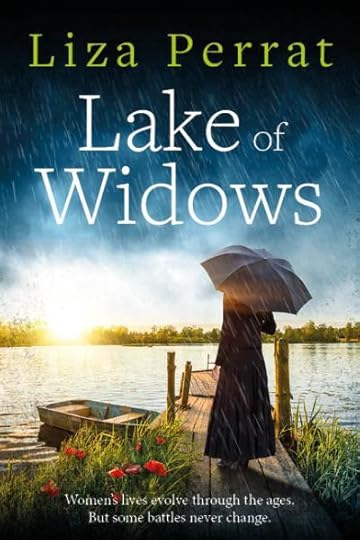
Liza: Ah, that’s the big question, Debbie! I’m having a writing break now, as I’ve just retired and need to organise the next “chapter” of my life. That said, I recently read an article about the sculptress, and lover of Rodin, Camille Claudel, after whom we named our eldest daughter. Her sad life intrigues me, so a last novel in the trilogy could well address Camille Claudel, and thus could be titled: Lake of Madness.
Debbie: Oh wow, that sounds fascinating, Liza – I’ll look forward to reading that one too!
Liza, thank you so much for joining us here today to share those fascinating insights into your writing life. I urge anyone who hasn’t tried your books yet to pick a series and give it a go – they’re in for a treat of intelligent, lyrical writing with a vivid sense of place, complex characters, and moving stories. Enjoy!
Liza: And many thanks to you, Debbie, for having me on your blog today.
FOR MORE INFORMATION ABOUT LIZA PERRAT AND HER BOOKSPlease visit her website: www.lizaperrat.com.
You can also find her on Facebook here and on Instagram at @liza_perrat_author.
All of Liza’s books area available as ebooks and in print to buy online and to order from good bookshops everywhere.
***And if you’re wondering who is the genius behind Liza’s gorgeous book cover designs, it’s Jane Dixon-Smith of J D Smith Designs. Every cover a work of art!***
 Liza and me enjoying a breezy writing retreat in Cornwall together, with Karen Inglis (left) and Lorna Fergusson (right)IN OTHER NEWS
Liza and me enjoying a breezy writing retreat in Cornwall together, with Karen Inglis (left) and Lorna Fergusson (right)IN OTHER NEWS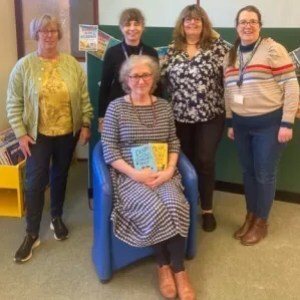 Huge thanks the lovely librarians for hosting our event on Saturay – and to Rachie Axford for the photo.
Huge thanks the lovely librarians for hosting our event on Saturay – and to Rachie Axford for the photo.While Death at the Old Curiosity Shop, my first book in the Cotswold Curiosity Shop mystery series continues to sell well (at #2 in the Cosy Mystery UK Kindle charts as I type!), I spent yesterday writing launch material for the next in the series, Death at the Village Chess Club, which will be published by Boldwood Books on Monday 3rd March. I enjoyed giving a sneak preview of the new book in a talk at Thornbury Library last Saturday, a double-act with my new author chum Anna Britton, who writes police procedurals. Hoping to have her on here as a guest soon too!
Also last week, I went to the first cast read-through of my new murder mystery play, to be premiered by Hawkesbury Drama Group on Friday 25th and Saturday 26th April. It’s about an amateur dramatic club whose intended production of The Importance of Being Earnest is scuppered by the murder of one of the cast. Here’s the graphic the design wizard of Hawkesbury Drama Group has just produced to promote the play. Full poster to follow soon!
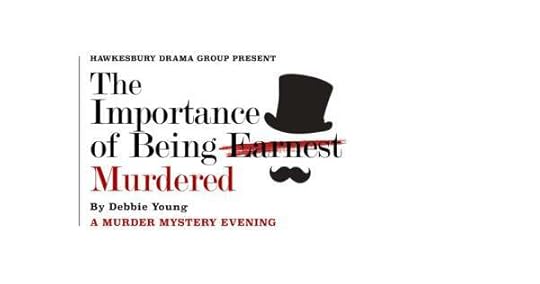
February 15, 2025
WHATEVER THE WEATHER: In Praise of Temperature Blankets
Filing my tax return just before a significant birthday last month, Benjamin Franklin’s dictum that “nothing is certain in life except death and taxes” hit home. Seeking uncertainties as an antidote, I turned to thinking about English weather. What could be more uncertain? Perhaps that’s why we talk about it so much. According to social anthropologist Kate Fox, author of Watching the English, every hour of the day at least a third of the population of England remarks on the weather.
I’m one of them. The weather app on my phone is one of the first things I look at each morning. I’ve usually forgotten the details by the next day, but this year, a new craft project is helping me produce a lasting record of one aspect of those addictive meteorological reports: the temperature blanket.
I first heard about temperature blankets during lockdown, but I’d already begun a pandemic knitting project—a throw featuring the colours of the Scottish Highlands that we missed visiting during the Covid years.
 My lockdown project – a blanket in the colours of the Scottish Highlands
My lockdown project – a blanket in the colours of the Scottish Highlands
But at the start of January, I decided that 2025 would be my year of the temperature blanket.
What is a temperature blanket exactly?
At the start of the year, you pick yarn in a colour palette with particular shades representing different thermometer readings. To keep it simple, allocate one colour to every few degrees rather than to every number. (For my blanket, I’ve chosen one colour to five degrees centigrade.)
Knitting a couple of rows to reflect each day’s temperature, it’s fun to watch the stripes build up.
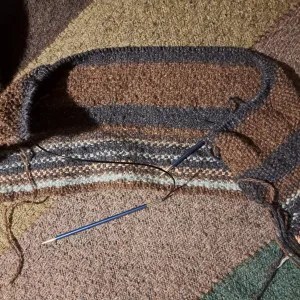 The wide stripes show how consistent the weather had been in February, while the narrow stripes at the bottom indicate a more varied January. I’m knitting it in linen stitch, which creates a woven effect. (See header picture for close-up.)
The wide stripes show how consistent the weather had been in February, while the narrow stripes at the bottom indicate a more varied January. I’m knitting it in linen stitch, which creates a woven effect. (See header picture for close-up.)For a smaller-scale challenge, apply the same thinking to a jumper or a scarf. A scientifically-minded friend is knitting a reversible scarf with minimum daily temperature on one side and maximum on the other.
If knitting isn’t your thing, you might crochet a row or a new granny square each day, or sew a colour-coded patchwork quilt.
Not into needlework? Apply the same principles to other crafts such as weaving, stringing beads, or abstract painting. You could even just colour in the squares for each day on a calendar or year planner.
Customise your project to suit your personal tastes. You don’t have to choose the obvious shades to represent temperatures—white for freezing, red for scorching hot, etc.
Although I’m a meteorologist’s daughter, my approach is more aesthetic than scientific.
I picked yarn to match my Scottish Highlands blanket, also the colour scheme for my front room.
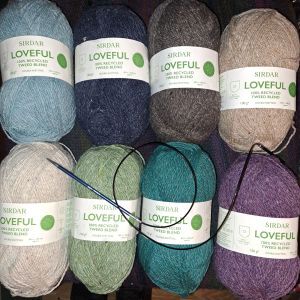 My choice of colour template in temperature order, from below freezing top left, to a warm purple for summer bottom right
My choice of colour template in temperature order, from below freezing top left, to a warm purple for summer bottom rightAre you wishing I’d told you about this new year challenge earlier so that you could start your project from January 1st? Make up for lost time by visiting the website www.temperature-blanket.com, which will tell you the historic temperature anywhere in the world, including Tetbury.
Looking forward to knitting my two rows in the appropriate colour each evening makes me talk less about the weather during the rest of the day.
The downside? I spend an alarming amount of time telling people all about my temperature blanket instead.
(This post first appeared in the Tetbury Advertiser’s February 2025 edition.)
IN OTHER NEWS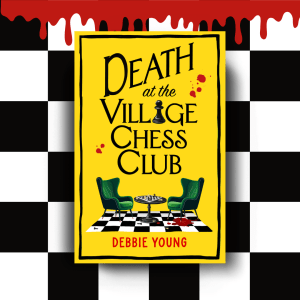 Coming on 3rd March!
Coming on 3rd March!With just over two weeks to go until the launch of Death at the Village Chess Club, I’m thrilled that the first in this new series, Death at the Old Curiosity Shop, is doing really well, thanks to smart marketing by my publisher Boldwood Books. For the last few weeks, it’s been consistently in the top 100 bestsellers of the UK Kindle chart, and as high as #2 in the Cosy Mystery chart. I’m hoping lots of the readers enjoying the first book will order this sequel!
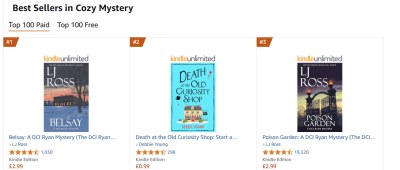
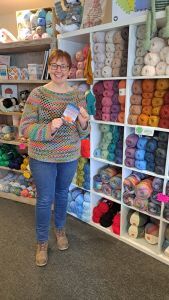 So pleased to have my little knitting mystery stocked in a knitting shop!
So pleased to have my little knitting mystery stocked in a knitting shop!Knitting features in Death at the Village Chess Club and will also be a focal point in the sequel – but this isn’t the first time I’ve written about it in my fiction. I’m pleased to announce that The Wool Cellar in Chipping Sodbury will shortly be stocking my novelette The Natter of Knitters, which was published back in 2020. It made Jo, the proprietor, laugh so much that she’s asked permission to print out quotes about knitting from it to pin up around her shop. What fun!
After getting a bit snowed under with live events last year, I’m rationing myself to just one a month in 2025, and a week today, Saturday 22nd February at 2pm, will be my February event – a joint talk with fellow crime writer Anna Britton at Thornbury Library, Thornbury, near Bristol, BS35 2AA. Anna and I write very different sub-genres of crime fiction – hers is police procedural, and mine is cosy mystery. We’ll have fun talking about the similarities and differences in our work, and about our writing lives.
Click here to find out more about it and to book your ticket via Eventbrite. We’d love to see you there!
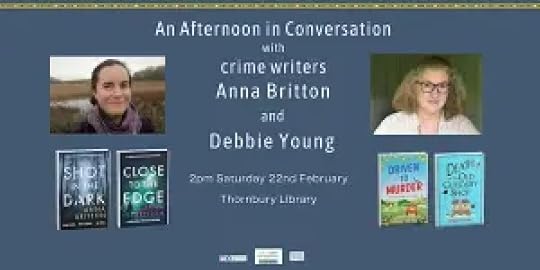
 No prizes for guessing what I’m reading this week: Anna Britton’s first novel Shot in the Dark. It’s an assured debut with an interesting structure, featuring a two-woman team of two female detectives. The strapline on its cover – “Three bullets – five suspects – no alibis” – is very intriguing, and I’m gripped!
No prizes for guessing what I’m reading this week: Anna Britton’s first novel Shot in the Dark. It’s an assured debut with an interesting structure, featuring a two-woman team of two female detectives. The strapline on its cover – “Three bullets – five suspects – no alibis” – is very intriguing, and I’m gripped!
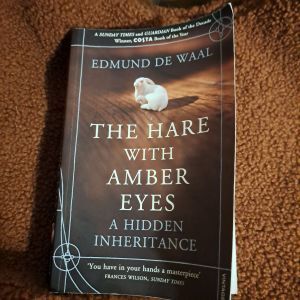 Rather a different read from the book I’ve just finished reading: ceramicist Edmund de Waal’s Hare with Amber Eyes, a remarkable multi-generational family history focused around his ancestor’s collection of 264 netsuke, which migrate from Japan to Paris to Vienna to Japan in the hands of those who inherit them. I chose this book as I wanted to learn more about netsuke – intricately carved Japanese toggles used to attach purses to kimono sashes. Why? Because they’ll be featuring in the third book in the Cotswold Curiosity Shop series, my current work-in-progress. More news on that soon!
Rather a different read from the book I’ve just finished reading: ceramicist Edmund de Waal’s Hare with Amber Eyes, a remarkable multi-generational family history focused around his ancestor’s collection of 264 netsuke, which migrate from Japan to Paris to Vienna to Japan in the hands of those who inherit them. I chose this book as I wanted to learn more about netsuke – intricately carved Japanese toggles used to attach purses to kimono sashes. Why? Because they’ll be featuring in the third book in the Cotswold Curiosity Shop series, my current work-in-progress. More news on that soon!
February 5, 2025
Wake Me Up When It’s March
 If it weren’t for my aversion to honey, I’d believe that in a former life I must have been a bear. As soon as the clocks go back in the autumn, I sleep a little longer each night, peaking at ten hours in midwinter. I hate the short days and long nights of winter.
If it weren’t for my aversion to honey, I’d believe that in a former life I must have been a bear. As soon as the clocks go back in the autumn, I sleep a little longer each night, peaking at ten hours in midwinter. I hate the short days and long nights of winter.
Fortunately, being a part of Hawkesbury Choir brightens the dark days of November and December as we practise uplifting Christmas music and sing at Advent services. The week following Christmas Day, I look forward to celebrating my mum’s birthday on New Year’s Eve.
 Identity parade of Hawkesbury Choir – I’m on the far right of the picture (Photo by our choirmaster Ben Humphries)
Identity parade of Hawkesbury Choir – I’m on the far right of the picture (Photo by our choirmaster Ben Humphries)But once we’re into the new year, the only highlight of the rest of the winter is my birthday mid-January.
After that, I’d be happy to hibernate until 1st March—the first day of meteorological spring.
What is hibernation exactly? It’s not just a long lie-in, but a special form of sleep known as torpor.
Torpor conserves energy by reducing the body’s temperature, pulse rate, breathing frequency, metabolism, and brain activity. The dwarf lemur, the only primate to hibernate, lowers its heart rate from 300 beats per minute 6 and its 60 breaths per minute to one every ten minutes, and reduces its brain activity so much that it is undetectable.
Even in torpor, staying alive consumes a lot of energy, substantially reducing the hibernator’s body weight. A squirrel, for example, typically loses 40% of its body weight during its winter sleep.
But that’s good news. What better way for humans to shed the evidence of an over-indulgent Christmas than by spending January and February asleep? Who needs expensive Ozempic when you can just sleep excess weight away? Christmas feasting would then become a wise survival technique rather than an act of greed and decadence.
Apparently, the deep sleep of hibernation can boost your natural immunity, thus lengthening your waking life.
A further health benefit is that the lack of social mixing while we sleep would reduce disease transmission. That would do away with the frightful 100-day cough and four major viruses that have overwhelmed the NHS this winter.
If you’re wondering how you’d manage to sleep for so long, any cat will be glad to show you how.
 Sleep is Dorothy’s special subject
Sleep is Dorothy’s special subjectBut it would take a lot of practice to match the staying power of the edible dormouse (glis glis). Hibernating for up to 11 months per year, it stores an enormous amount of fat during its one waking month. Hence its popularity as a tasty snack for Ancient Romans. (I knew there had to be a downside.)
So, if you don’t see me around for the rest of this month, you will know what I’ll be doing. But don’t worry, I’ll be setting my alarm for 1st March. After all, it is my husband’s birthday.
See you in the spring!
(This post first appeared as a column in the February 2025 issue of the Hawkebury Parish News.)
IN OTHER NEWS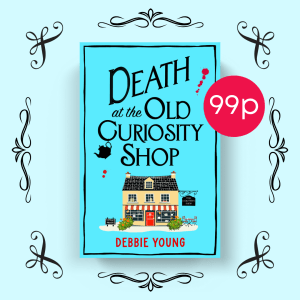 The ebook of the first in my latest cosy mystery series, Death at the Old Curiosity Shop, is currently on a special 99p/99c promotion in the UK, the USA, Australia and Canada, organised by my publisher Boldwood Books. Apologies to readers in other countries that this offer doesn’t apply to you.
The ebook of the first in my latest cosy mystery series, Death at the Old Curiosity Shop, is currently on a special 99p/99c promotion in the UK, the USA, Australia and Canada, organised by my publisher Boldwood Books. Apologies to readers in other countries that this offer doesn’t apply to you.
Meanwhile the sequel, Death at the Village Chess Club, is due to launch on Monday 3rd March, and is already available to preorder in certain formats. From launch day it will be available in ebook, paperback, hardback and audiobook.
And I’m currently writing book three in this planned trilogy, working title Death at the Village Christmas Fair, which will be published in time for Christmas 2025. I love the covers Boldwood has produced for the first two and can’t wait to see what the third cover will be like!

I’m also about to give my first talk of the year, in an online Zoom session this evening for Jericho Writers. I love helping other authors, whether by giving talks to writers’ groups or via one-to-one mentoring sessions. I’ve made many new friends this way and discovered lots of new books to read, including some that take me outside of my usual reading comfort zone.
WHAT I’M READINGThis is a new footnote to my weekly blog posts – a summary of book recommendations spanning a wide range of genres which I hope will appeal to all kinds of readers.
[image error] [image error]
This week, I’ve been reading some terrific epic fantasy fiction by Ulana Dabbs, who creates vibrant fantasy worlds rich with human emotion. A good starting point to discover Ulana’s work is Fated Daggers, a free short story, which you can download as a free ebook from her (beautiful) website at www.ulanadabbs.com. I then went on to buy her novella, The Wrath of Skaldir, which is a prequel to her trilogy set in the world of Lumi. Ulana was telling me that her next planned fantasy series will be influenced by her fascination for all things Japanese, and I am looking forward to discovering that series too when it’s ready.
I highly recommend Ulana’s work for anyone of any age who enjoys epic fantasy with feisty heroines.
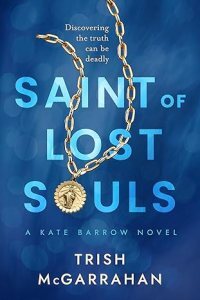
I’m also excited to see that Trish McGarrahan, who I got to know last autumn, has just published her debut novel, Saint of Lost Souls, the first in her Kate Barrow series of thrillers set mainly in the US and partly in Durham, England. After a personal tragedy forces Kate to abandon her dream of becoming an archaeologist, she is working as a defence contracts administrator when she realises someone is trailing her with malicious intent – and she will not rest until she discovers the truth. I was really gripped by a pre-publication version of this tense, well-written story, which is driven by strong characterisation as well as by action. I’m now about to enjoy reading the final version, and I look forward to the next installment of Kate Barrow’s adventures. Find out more about Trish and her new book at her website,www.trishmcgarrahan.com
A terrific read for anyone who loves tense thrillers centred around strong characters in intriguing settings.
January 29, 2025
In Conversation with Author Lorna Fergusson
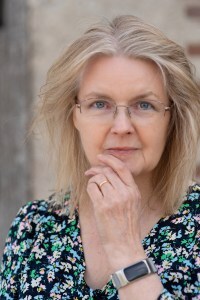 At the end of each month, I like to share a conversation with an author friend about our writing lives. For my first “In Conversation” post of 2025, I’m delighted to welcome Lorna Fergusson, author, editor, writing coach, speaker, and a wise and generous mentor.
At the end of each month, I like to share a conversation with an author friend about our writing lives. For my first “In Conversation” post of 2025, I’m delighted to welcome Lorna Fergusson, author, editor, writing coach, speaker, and a wise and generous mentor.
Although we live too far apart to meet frequently in real life, we have enjoyed writing retreats together and have occasionally been speakers at the same events.
Like me, Lorna is always busy juggling different book-related tasks in between writing her own work, so it’s always a cause for celebration when she publishes new fiction. Today, we’re talking particularly about One Morning in Provence, her new collection of short stories, set in France, and about creating a sense of place in fiction.
Debbie: Like your novel, The Chase, your new book, One Morning in Provence, is set in France. Your lyrical and original writings are filled with love for rural France. Why is this area so special to you – and so stimulating creatively?
Lorna: When I wrote The Chase, quite a number of years ago now, it was inspired by the Dordogne region of France. My husband and I had a half-share in a holiday home near Bergerac for some years and part of the novel was actually written there, celebrating my love for the culture, history and landscape.
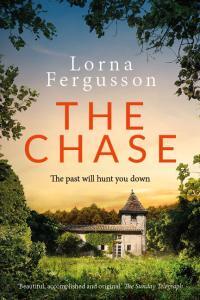 The highly acclaimed “The Chase” has recently been reissued with a gorgeous new cover
The highly acclaimed “The Chase” has recently been reissued with a gorgeous new coverWriting One Morning in Provence was a bit of a revelation because it came so easily to me, to tap into memories of other visits to France throughout my life. Each story in the collection is based in a particular location I’ve visited.
The book has reinforced what I’ve always known, that all my stories are anchored in place and the spirit of place. I find descriptive writing really fulfilling and if I feel I can transport a reader to the location I’m describing, that feels great!
It was extraordinary how intense my sensory memories, all the way back to girlhood, were. All I had to do was imagine new characters and how these places might affect them!
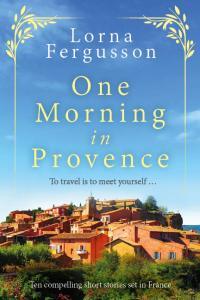 Lorna Fergusson’s collection of evocative short stories was published in December 2024.
Lorna Fergusson’s collection of evocative short stories was published in December 2024.Debbie: To what extent does the place become almost another character in your writing?
Lorna: I do think that our travels have a deep and abiding effect on us. It’s just the same as when you meet people – for some you feel an immediate antipathy, some are just ‘meh!’, and some become soulmates very quickly.
When we travel our senses are on high alert: we notice more, we feel more. And that, in these stories, can trigger unexpected feelings, decisions and transformations in the characters I bring to these settings. So they engage with setting the way they might engage with another human being – and they are certainly never impervious to it.
 This map shows the settings of the stories in “One Morning in Provence”
This map shows the settings of the stories in “One Morning in Provence”Debbie: Although your setting for these stories is France, the main characters are all English, transformed in some way by their visit to the country. The French characters are very minor. Why did you write almost exclusively about “the Englishman/woman abroad”?
Lorna: This connects with what I’ve just been saying: if the characters lived in these places all the time, they would be a little ‘dulled’ somehow, taking for granted the beauty and resonance of what’s around them.
I didn’t really plan it in a cold-blooded, rational way – it was an instinctive approach. At some point it dawned on me that story after story was from the stand-point of a visitor, someone transitory, someone who would take away with them the meaning of their visit, someone changed by it.
Debbie: What other places dear to you have inspired stories, past, present or planned for the future?
Lorna: I love the far west of Cornwall and have set some as-yet unpublished work there.
Debbie: Me too! I’m hoping that we’ll both be sharing those works before too long. And thank you so much for the support and encouragement you’ve given me so far in developing my Cornish novel.
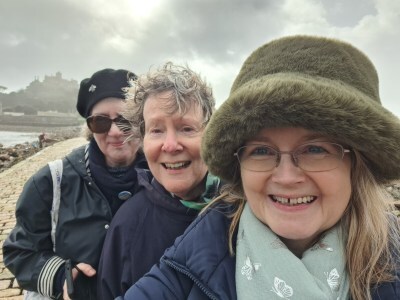 A souvenir of an inspiring writing retreat near St Michael’s Mount, Cornwall – I’m back left, thriller author Alison Morton is in the middle, and Lorna, who took the selfie, is on the far right
A souvenir of an inspiring writing retreat near St Michael’s Mount, Cornwall – I’m back left, thriller author Alison Morton is in the middle, and Lorna, who took the selfie, is on the far rightLorna: And there’s Oxford, of course, where I live and Scotland, where I come from.
The challenge when it comes to location is how to find a new spin if it is a place people already feel they know very well!
Debbie: That’s a very good point. As you know, my fiction is mostly set in the Cotswolds, a hugely popular region with writers and readers alike, where I’ve lived for over 30 years. I think you can’t beat real, lived experience for distinguishing your work in a well-known setting. First first-hand knowledge of a place will always trump research in making a story convincing and compelling, whether fiction or non-fiction, short or long.
Like me, you’ve always loved to write short stories as well as full-length fiction. What do short stories allow you to express that the novel doesn’t?
Lorna: Short stories are all about concentration. I’m delighted that this is a form experiencing something of a revival lately, because readers are challenged to find time to focus, and some don’t actually enjoy staying with an extended story over the long haul.
The thing about short stories for me is that they are a kind of ambush. You go in expecting something relatively light, brief, even trivial. But at their best, they’re none of these things.They offer the satisfaction of a tight construction, with an audible ‘click’ at the end as everything falls into place or twists into the unexpected.They also offer resonance – an effect that lasts long after you’ve read the last word.The characters may be on the page for a short time but they may stay in your mind for years.Finally, I think a good story gives you a sense of what is happening beyond its boundaries. It’s as if you know more about the people that you’ve been told, as if their lives go on in some way off the page.Debbie: That’s a compelling and eloquent justification for the anyone to start reading short fiction. Yet many novelists shy away from trying to write short stories as they find them too difficult. As a writing coach, what are three top pieces of guidance you’d offer to anyhone trying to write short stories?
Lorna: I think it is totally understandable that writers find short stories difficult to write. A novel is daunting in its own way, of course – all those words, all those pages. But it gives you time to stretch, even to indulge yourself with a big cast, detailed plots, sub-plots and so on.
By comparison a short story is a corset. It seems too tight and inhibiting. But for me, that is the challenge I love. It’s a Fabergé egg, in writing terms: jewelled, detailed, miniature.
I have always loved finding out where a story will take me, working with its inner beats and turns, finding that right ending.
That’s why writing One Morning in Provence was one of the most pleasurable writing experiences I’ve ever had.
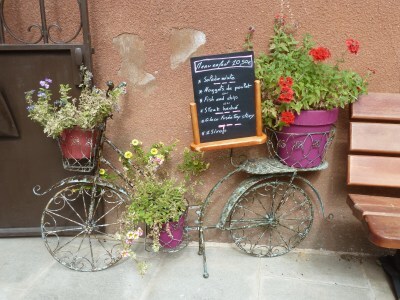
As for three top tips, well, here they are:
You don’t have time to faff around on the first page: get into the story, don’t get lost in back story or scene-setting. Get your reader into a situation and more than that, the psyche of the person who is in that situation, as soon as you can.Vary what you are doing: descriptive writing needs to justify its presence. Break long blocks up with judicious use of dialogue which is often the most economical way to give us an insight into character and interaction.Pace the story so that it breaks into natural phases: readers love to feel they are being taken by the hand and guided through, that the writer is in control and that a destination is coming which will be worth reaching. Think of how your last line or paragraph is going to resonate with them. Will they feel something? Shocked? Uplifted? Tearful? Any emotion is good – as long as they are not feeling cheated or let-down.One piece of advice you may well have come across is that a short story should have a single viewpoint. Rubbish. I have enjoyed playing with points of view in mine and if you carefully control what you are doing, you can introduce more than one. I have four in one of my One Morning in Provence stories!
 The perfect accompaniment for savouring Lorna’s stories set in Provence!
The perfect accompaniment for savouring Lorna’s stories set in Provence!Debbie: I’ve heard many avid readers say they dislike short stories, but when I press them, it often turns out they’ve hardly read any! I often recommend Ray Bradbury and Saki as an entry point to the joy of short fiction. Who would you suggest?
Lorna: Off the top of my head I’d say Margaret Atwood, Rose Tremain, Kate Atkinson and the American writer Ron Rash.
Debbie: What are you writing now? What are your writing/coaching/editing plans for 2025?
Lorna: Last year, I decided to recalibrate how I balance writing with my coaching and editing work, so I want to continue doing that in 2025. It has been a joy to rediscover my writing – and more importantly – my publishing mojo!
I hope to finish a book on mindset for writers that I have been working on for a few years, plus I am partway through a novel that was inspired by a short story which was runner-up for the Mogford Prize in 2021.I have more short story collections in mind, plus poetry collections.I’ll be spending most of my summer teaching on Oxford University’s creative writing summer schools.I have some novels to edit for clients, so it is shaping up to be a busy year.Debbie: Lorna, thank you so much for joining me in conversation today and sharing your insightful and thought-provoking comments. For anyone who hasn’t yet read One Morning in Provence, I highly recommend it as a warm, uplifting read for these dark wintry days (in the northern hemisphere where Lorna and I are, at least) – or as a great accompaniment on any holiday, to raise your awareness of how travel might affect you too.
FIND OUT MORE ABOUT LORNA FERGUSSON Lorna Fergusson is a writing coach, editor and speaker, author of The Chase and An Oxford Vengeance. She runs Fictionfire Literary Consultancy and has taught on various Oxford University writing programmes since 2002. Her stories have won an Ian St James Award, the Historical Novel Society’s Short Story Award, and been shortlisted for the Bridport Prize and Pan Macmillan’s Write Now prize. In 2021 and 2022 she was runner-up for the Mogford Prize. She is developing one of the Mogford stories as a novel, as well as working on poetry and a book on mindset for writers. Her latest book is One Morning in Provence, a collection of stories set in France.
Lorna Fergusson is a writing coach, editor and speaker, author of The Chase and An Oxford Vengeance. She runs Fictionfire Literary Consultancy and has taught on various Oxford University writing programmes since 2002. Her stories have won an Ian St James Award, the Historical Novel Society’s Short Story Award, and been shortlisted for the Bridport Prize and Pan Macmillan’s Write Now prize. In 2021 and 2022 she was runner-up for the Mogford Prize. She is developing one of the Mogford stories as a novel, as well as working on poetry and a book on mindset for writers. Her latest book is One Morning in Provence, a collection of stories set in France.
Connect with Lorna online:
Websites: www.lornafergusson.com & www.fictionfire.co.uk
Facebook: @LornaFergussonAuthor
Twitter: @LornaFergusson.
Buy her books:
One Morning in Provence ~ The Chase ~ An Oxford Vengeance
January 17, 2025
With My Writing Hat On…
I’ve been a hat addict all my life. In winter I’m usually seen in a beret, and in the summer a linen sunhat. People often say to me, “Ooh, I didn’t recognise you without a hat”.
I have two particularly fond memories of hats from my childhood. I loved my green Amish bonnet, bought at the age of 8 when my family lived briefly near Pennsylvania Dutch country. At that age, I considered the sect’s dress to be glamorous and desirable, which would probably have horrified the Amish if they knew, and I kept it for many years.
My smart red straw cowboy hat, bought a month later when we visited Yellowstone Park, didn’t last me as long. To my family’s horror, as we stood on the boardwalk by the famous Morning Glory pool, a gust of wind lifted my hat off my head and dropped it into the deep blue waters. We fled in embarrassment as the red dye in my hat started to turn the pool purple.
 Photo: Public Domain, via https://commons.wikimedia.org/w/index.php?curid=289408
Photo: Public Domain, via https://commons.wikimedia.org/w/index.php?curid=289408These days, as a busy multi-tasker, I often preface a comment “with my (insert current role here) hat on” – eg with my village choir hat on, my bellringing hat on, my Friends of St Mary’s hat on, etc etc, to make my perspective clear. Until now, all these hats have been metaphorical, as none of these involve actual hats.
We don cheerful red robes when singing with the choir. (I’m pictured on the far left here outside Great Badminton Church.)
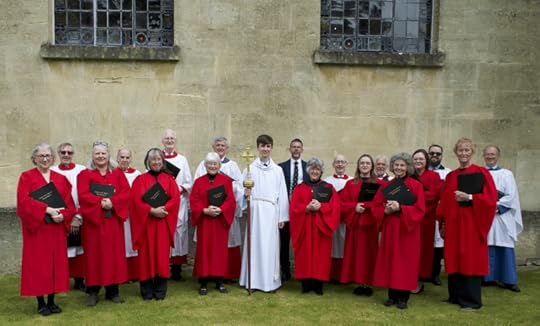 Photo by Sir Ian Macfadyen
Photo by Sir Ian MacfadyenFor bellringing, accessories are positively discouraged because they’re potentiall hazardous as we go about the robust business of heaving on the bell ropes. Scarves in particular are banned, because if it became entangled in your bell rope as it rises to the ceiling, it could strangle you. I even remove my glasses when I’m bellringing these days, having once caught them with the end of the rope, which sent them flying off the ringing platform and halfway down the nave below.
 An accident waiting to happen! Photo by Anne Bishop
An accident waiting to happen! Photo by Anne BishopThe closest we have to a Friends of St Mary’s hat is a smart red apron, which we wear when dispensing refreshments at fundraising events – modelled below by my friend Pauline and me at an outdoor event a couple of summers ago.
 Up to mischief with fellow Friends of St Mary’s members Paulina and Pam (Photo by Colin Dixon)
Up to mischief with fellow Friends of St Mary’s members Paulina and Pam (Photo by Colin Dixon)So I was pleased to receive an actual writing hat last month as my Christmas present from my publisher, Boldwood Books. Boldwood takes great care of its authors, coming up with a fun Christmas gift each year, always in its distinctive corporate orange. This hat will go well with the previous year’s gift of a Boldwood umbrella.
 Time to don my writing hat…
Time to don my writing hat…I suspect most writers have set rituals and preferred tools that help them get in the zone for writing, whether sitting in a particular place or using a favourite pen or notebook. I’m like that myself – I favour pen and ink for first drafts, ideally wielded at the oak pedestal desk in my writing hut at the bottom of the garden.
As I’m planning to spend the rest of the winter in my writing hut, working on the third mystery novel in my Cotswold Curiosity Shop trilogy, I’m hoping that donning my Boldwood Books hat at the start of each session will kickstart the creative part of my brain – or at the very least, stop it from freezing over.
IN OTHER NEWS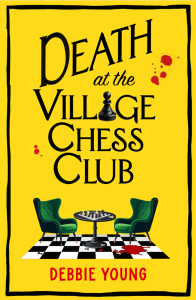 Speaking of Boldwood Books, I’m pleased to reveal the new cover for the second Cotswold Curiosity Shop cosy mystery – which by chance matches my new hat very well!
Speaking of Boldwood Books, I’m pleased to reveal the new cover for the second Cotswold Curiosity Shop cosy mystery – which by chance matches my new hat very well!
In Death at the Village Chess Club, the murder mystery revolves around old chess sets that Alice agrees to sell for her ex-partner Steven, once an avid collector. Several interesting new characters join those from the first book. I particularly enjoyed introducing Alice’s mother Wendy, staff from the village primary school, and a remarkable gang of bikers with a surprising passion for chess.
Death at the Village Chess Club will be launched on 3rd March, in paperback, ebook, audiobook and hardback. It’s already available to pre-order online here, or ask your local bookshop or library to order it in for you.
Meanwhile, the first in the series, Death at the Old Curiosity Shop, is still riding high in the charts, and the ebook ontinues to be available at a special price of £1.39 on Amazon’s UK site, and at various offer prices on other sites around the world. So if you haven’t already read it, now would be a good time! Order online here, or request at your local bookshop or library.
Now, back to work on the third book in the series – with my writing hat on!
January 8, 2025
Why I’m Writing a Play
With a new novel to write by the end of March (the third in my Cotswold Curiosity Shop cosy mystery series), why have I found myself promising my local village drama group a brand new play by the beginning of March? I may be good at multitasking, but this is quite a commitment, even for me…
Firstly, flattery gets you everywhere. When the Hawkesbury Drama Group asked me to write them a murder mystery event, I felt honoured – especially when they told me that it shouldn’t be based on one of my mystery novels, as lots of their target audience will already have read them. Their further request to write two different endings, so that they could run the show on consecutive nights, proved an irresistible challenge.
Secondly, I have a great deal of respect for Hawkesbury Drama Group. They’ve been putting on highly entertaining plays and pantomimes for years, to packed houses of all ages. With tickets for professional productions so expensive these days, and with the nearest theatre fifteen miles away, Hawkesbury Drama Group brings the joy of live theatre to our doorstep at affordable admission prices. For many villagers, including those who don’t have access to their own transport, its productions are the only live shows they’ll see all year.
Hawkesbury Drama Group also runs drama workshops for adults and children. These have given many young people, my daughter included, the enthusiasm, experience and confidence, to go on to join productions both in the village and further afield.
Although I’ve never taken part in one of their shows, I enjoy doing “front of house” duties for most of their productions. In the picture above, I was chuffed to discover their hardworking production crew had created an actual box office. They also have great after-show parties for cast and crew!
In addition, the request taps into a love of theatre that goes back to my childhood – particularly amateur dramatics. In this I was encouraged by my mother, a talented amateur actress.
One of my favourite books when I was a child was The Swish of the Curtain by Pamela Brown when she was a teenager, about a group of children who set up their own theatre company.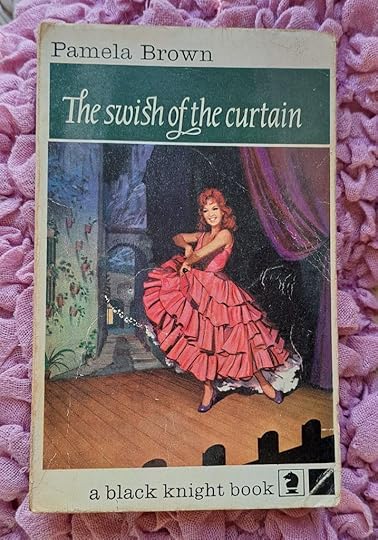 I must have read this dozens of times – pure wish fulfilment for any child dreaming of going on stage
I must have read this dozens of times – pure wish fulfilment for any child dreaming of going on stageI always loved taking part in school productions. I enjoyed being the Town Crier in the “Beavers in Blunderland” pantomime written for my secondary school in Chislehurst, Kent, then named Beaverwood School because it was in Beaverwood Road, and since renamed Chislehurst School for Girls. (Fun fact: in those days, the school houses had saints’ names, and I was in St Bride’s – to which I paid fond tribute by naming after it the school in my Gemma Lamb Cosy Mystery series.)On Saturday mornings, I was lucky to attend a children’s drama club at Rose Bruford College, which happened to be at the end of my road, Burnt Oak Lane, in Sidcup, in a beautiful park called The Glade. The club was run by drama students (often nursing hangovers from the previous Friday night). Whenever I go to see a professional play these days, I always check the actors’ bios to see whether any of them trained at Rose Bruford, and there’s always at least one. The college’s list of alumni is impressive, including Tom Baker, Matthew Baynton, and Gary Oldman.When my family moved to Germany aged 14, at Frankfurt International School I had great fun taking part in two school musical productions, Annie Get Your Gun and Guys and Dolls .After leaving university, I joined various amateur dramatic and amateur operatic groups. I played Charlotte Lucas in Pride and Prejudice in Tring. I was part of the chorus for several Gilbert and Sullivan productions in Tring and Winterbourne, including Princess Ida, Trial by Jury, HMS Pinafore, and Ruddigore.
I’ve been to many live productions over the years, both amateur and professional.
For my tenth birthday, instead of a party, my parents took me and my friends to see Alice in Wonderland at Eltham Little Theatre (now the Bob Hope Theatre – the famous comedian was born and raised in Eltham). I was especially thrilled when the Knave of Hearts, roaming around the audience with a plate of stolen jam tarts, stopped to give me one. For a moment I was convinced he knew it was my birthday.On holiday in Southwold when I was about 11, my family went to the local amateur production of Noel Coward’s Blithe Spirit , and I loved it so much I went back to see it again on my own the next night.At university in York, I witnessed a particularly memorable open-air production of Shakespeare’s The Tempest in the gardens of the medieval Merchant Venturer’s Hall. By an amazing coincidence, a genuine thunderstorm blew up at exactly the right point in the play. What are the chances?!I recently enjoyed a hilarious and highly musical murder mystery night, Murder at the Opera, by Cardiff Cotswold Opera, in St George’s Church, Nailsworth, featuring songs from high opera to Broadway musical.
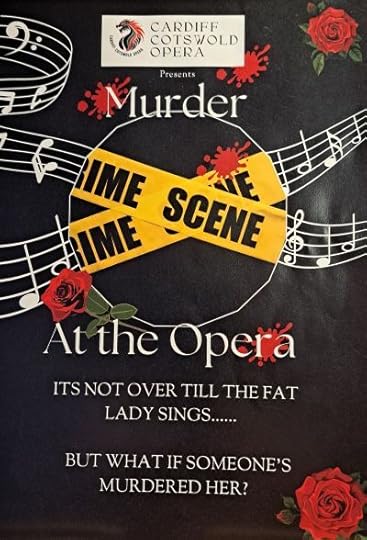
Where I live now, we’re lucky to be on the circuit of several touring theatrical companies. We’ve seen many open-air productions of Shakespeare and Restoration Comedy in stunning settings from the medieval courtyard of The New Inn in Gloucester, contemporaneous to Shakespeare himself, to the futuristic Swinhay House near North Nibley.
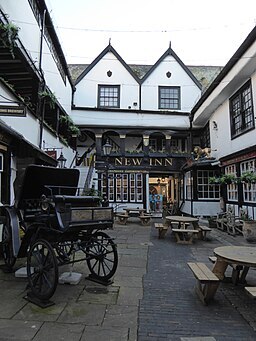 Watching a live performance of “A Midsummer Night’s Dream” in this authentic medieval coaching inn’s courtyard, it’s easy to imagine the cast includes the playwright himself.
Watching a live performance of “A Midsummer Night’s Dream” in this authentic medieval coaching inn’s courtyard, it’s easy to imagine the cast includes the playwright himself.Will my lifelong love of theatre equip me to write a convincing murder mystery play, in which the audience are invited to play detective? I’m going to have fun finding out!
Rehearsals for my new play start early February, with performances planned for 25th-26th April. If you’d like to attend, follow Hawkesbury Drama Group on Facebook here to find out when tickets go on sale.
IN OTHER NEWS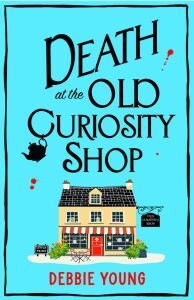 Back to post-holiday-season reality now, I’m looking forward to the launch of my next novel, Death at the Village Chess Club, on 3rd March – the sequel to the popular Death at the Old Curiosity Shop. On next week’s post, I’ll be revealing the gorgeous new cover in a decidedly spring-like colour. If you don’t already “follow” this blog, and would like to receive each new post in your email inbox, click the “Follow blog” button about halfway down the right-hand sidebar of this page.
Back to post-holiday-season reality now, I’m looking forward to the launch of my next novel, Death at the Village Chess Club, on 3rd March – the sequel to the popular Death at the Old Curiosity Shop. On next week’s post, I’ll be revealing the gorgeous new cover in a decidedly spring-like colour. If you don’t already “follow” this blog, and would like to receive each new post in your email inbox, click the “Follow blog” button about halfway down the right-hand sidebar of this page.
I’m also about to start reading Anna Britton’s debut novel, Shot in the Dark, to prepare for our “Afternoon In Conversation” event at Thornbury Library, Gloucestershire, on Saturday 22nd February. Tickets are now on sale here, at just £5 per head, to include refreshments. Please book in advance to help the wonderful library staff rustle up enough refreshments to go around!
January 1, 2025
The Year of the Diary
New year, new beginnings – and one of my favourite forms of fresh start is a brand new diary.
For most of my life, I have kept a diary, jotting down the most memorable events of the day. Then in 2010, I swapped to blogging about once a week as my preferred vehicle for musing about my life.
But at the beginning of 2024, feeling the years were rushing by faster than ever, I decided to resume hand-writing an account of each day as it happened. I reasoned that writing a daily “done” list would make me feel better about never completing my always over-ambitious to-do list.
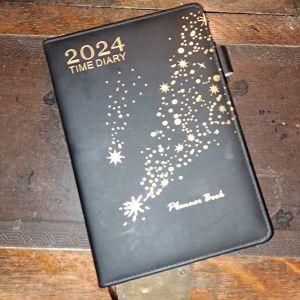 The purchase of this beautiful page-a-day diary encouraged me to write in it the whole year long
The purchase of this beautiful page-a-day diary encouraged me to write in it the whole year longI rarely read previous entries, but towards the end of the year, I noticed, glancing back, that nearly every day began “Another busy day…”
This discovery banished my fear that I wasn’t making the most of my allotted span. It also licensed me to grant myself more much-needed rest time.
Keeping a diary has always been good for mental health, whenever and whatever you choose to write in it.
Especially in an age when hand-writing is being increasingly replaced by typing on keyboards, there are physical rewards in writing in a special book by hand – the soothing rhythm of forming the words, the flow of the ink, the silky feel of the paper.
There’s a sense of accomplishment as you fill the book with a unique and personal record of your existence. It’s life-affirming.
As a diarist, you’re in excellent company. Real and fictitious diaries have a special place in our culture, from Samuel Pepys and Anne Frank to The Diary of a Nobody by George and Weedon Grossmith, The Diary of a Provincial Lady by E M Delafield, Adrian Mole and Bridget Jones.
Think you don’t have time to write a diary? Bear in mind that even Queen Victoria found space in her life for a daily diary habit. She kept a diary from 1832 to ten days before her death in 1901. She even wrote in Urdu for a while, to practise the lessons she was taking from her Indian servant Abdul Karim. Her example is making me rethink my daily Duolingo habit, although I’d need to expand my vocabulary to write a Latin diary – and master more than the present tense.
There are other ways to keep diaries, from illustrator Chris Riddell’s daily cartoon to my friend Linda Alvis’s photographic record of her travels, later translated into paintings and finally into written travelogue.
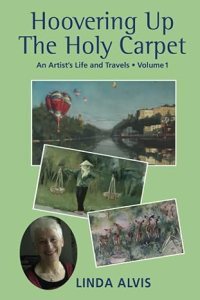
The “temperature blanket” is another record I’m planning to keep in 2025, knitting a nightly row in a colour determined by the day’s weather.
However you plan to keep track of your new year, I wish you a peaceful, healthy and fulfilling 2025.
 I was really pleased to be able to find exactly the same diary for the coming year
I was really pleased to be able to find exactly the same diary for the coming yearThis post was written for the January 2025 edition of the Hawkesbury Parish News.
IN OTHER NEWSLooking Back on 2024What did I achieve in 2024?
Writing Published two new novels – the ninth Sophie Sayers cosy mystery,
Driven to Murder
, launched on 26th January, and the first in a new trilogy,
Death at the Old Curiosity Shop
Wrote a third novel ready for launch on 3rd March 2025:
Death at the Village Chess Club
, the second in my new trilogyTaught my ten-week Simply Self Publish course twice for Jericho Writers, running April-June and October-December
(find out about the 2025 courses here)
Spoke at many different events including Troubador’s Self Publishing Conference and Jericho Writers’ London Festival of WritingRan two events for the Hawkesbury Upton Literature Festival, one with the theme of A Sense of Place in September at the parish church of St Mary’s Hawkesbury, and the other a Christmas Special in December in the village hallTook stalls at local events including the Hawkesbury Village Show and the Hawkesbury At Play Christmas Shopping EveningJudged the Young Writer competition at the local secondary schoolManaged to post on my blog most weeks, although my newsletter to my Readers’ Club subscribers was a bit sporadic – sorry about that!Reading
Published two new novels – the ninth Sophie Sayers cosy mystery,
Driven to Murder
, launched on 26th January, and the first in a new trilogy,
Death at the Old Curiosity Shop
Wrote a third novel ready for launch on 3rd March 2025:
Death at the Village Chess Club
, the second in my new trilogyTaught my ten-week Simply Self Publish course twice for Jericho Writers, running April-June and October-December
(find out about the 2025 courses here)
Spoke at many different events including Troubador’s Self Publishing Conference and Jericho Writers’ London Festival of WritingRan two events for the Hawkesbury Upton Literature Festival, one with the theme of A Sense of Place in September at the parish church of St Mary’s Hawkesbury, and the other a Christmas Special in December in the village hallTook stalls at local events including the Hawkesbury Village Show and the Hawkesbury At Play Christmas Shopping EveningJudged the Young Writer competition at the local secondary schoolManaged to post on my blog most weeks, although my newsletter to my Readers’ Club subscribers was a bit sporadic – sorry about that!Reading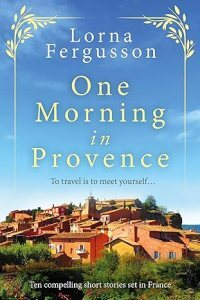 I’m pleased to say that Lorna Fergusson will be in conversation with me on my blog at the end of January
I’m pleased to say that Lorna Fergusson will be in conversation with me on my blog at the end of JanuaryRead widely and voraciously. I won’t share the number of books I read – it’s not a numbers game – but here are some of my favourites this year:
The 11th Inkblot by J Hermann KleigerThe Cry of a Bird by Dorothy IglesiasThe Quiet American by Graham GreeneA Time to Keep Silence by Patrick Leigh FermorThe White Umbrella by Brian SewellThe Notebook: A History of Thinking on Paper by Roland AllenUnder the Bridge by Anne BishopThe Box of Death by R MarsdenFor the Love of Mark Twain by Kalyn GensicArden by G D HarperThe History of Medicine in 12 Objects by Dr Carol CooperLake of Widows by Liza PerratTo Love and Serve by Mary FloodOne Day in Provence by Lorna FergussonWild Mary: The Life of Mary Wesley by Patrick MarnhanTravel
Visited Copenhagen with my daughter (21), also taking advantage of the local train network to travel further within Denmark and also to SwedenMade several trips ot Aberystwyth, where my daughter is in her final undergraduate yearVisited various family members in London, Sussex and SuffolkPersonal
Continued to be very active in village life, singing in the Hawkesbury Choir and bell ringing with the Hawkesbury RingersWas confirmed by the Bishop of Tewkesbury in St Catherine’s Chapel, Westonbirt SchoolTook a course and was commissioned as a Lay Worship Leader at St John the Evangelist’s Church in CharfieldJoined the PCC (Parochial Church Council) for my parish church of St Mary the Virgin, HawkesburyWas appointed secretary of the Friends of St Mary’s, after being on the committee for several years
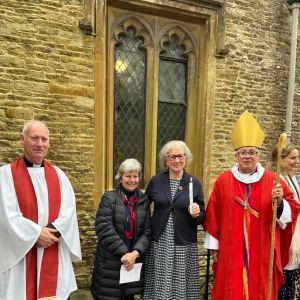 With our parish priest, the Rev Richard Thomson, my sponsor Lisa Overton, and the Bishop of TewkesburyLooking Forward to 2025
With our parish priest, the Rev Richard Thomson, my sponsor Lisa Overton, and the Bishop of TewkesburyLooking Forward to 2025What are my plans for 2025?
Writing Time to don my writing hat… a Christmas gift from my publisher Boldwood Books!On January 1st, I’ll be doing the final proofread of
Death at the Village Chess Club
On January 9th, my publisher, Boldwood Books will reveal the lovely new cover (I can’t wait to share it with you!)31st March is my publisher’s deadline for the third Cotswold Curiosity Shop mystery, which will be set at Christmas and launched early autumn 2025Also in January, I’ll be writing a murder mystery play for the Hawkesbury Drama Group (not the first play I’ve written, but the longest – I’ve previously written two skits for the Hawkesbury Youth Group, “The Simpsons Go to the Hawkesbury Show”, and another based on the comedy series Friends, of which I can’t remember the title!) Rehearsals start in February, and the show will be staged on Saturday 26th April – and also possibly on Friday 25th April, as they’ve asked me to write two different endings so they can do two performances!Other writing projects are still under wraps, but I’m pleased to have been asked to write “Golden Girls” novels for Boldwood Books, ie upbeat, fun stories about ladies of a certain ageThere’ll be two Hawkesbury Upton Literature Festival events, in September and December. More details to be announced soon.I’ll teach my ten-week Simply Self Publish course twice for Jericho Writers, running April-June and October-December
(find out about the 2025 courses here)
I’ll be speaking at no more than one event per month, so that I can focus most of my time on my writing commitments – so book now if you want me! There is always an up-to-date list of my speaking engagements in the sidebar of this website.I’m planning to post every Friday on my blog, or as close to it as I can, and to send my free Readers’ Club newsletter monthly. (Join my Readers’ Club here if you haven’t already.)Reading
Time to don my writing hat… a Christmas gift from my publisher Boldwood Books!On January 1st, I’ll be doing the final proofread of
Death at the Village Chess Club
On January 9th, my publisher, Boldwood Books will reveal the lovely new cover (I can’t wait to share it with you!)31st March is my publisher’s deadline for the third Cotswold Curiosity Shop mystery, which will be set at Christmas and launched early autumn 2025Also in January, I’ll be writing a murder mystery play for the Hawkesbury Drama Group (not the first play I’ve written, but the longest – I’ve previously written two skits for the Hawkesbury Youth Group, “The Simpsons Go to the Hawkesbury Show”, and another based on the comedy series Friends, of which I can’t remember the title!) Rehearsals start in February, and the show will be staged on Saturday 26th April – and also possibly on Friday 25th April, as they’ve asked me to write two different endings so they can do two performances!Other writing projects are still under wraps, but I’m pleased to have been asked to write “Golden Girls” novels for Boldwood Books, ie upbeat, fun stories about ladies of a certain ageThere’ll be two Hawkesbury Upton Literature Festival events, in September and December. More details to be announced soon.I’ll teach my ten-week Simply Self Publish course twice for Jericho Writers, running April-June and October-December
(find out about the 2025 courses here)
I’ll be speaking at no more than one event per month, so that I can focus most of my time on my writing commitments – so book now if you want me! There is always an up-to-date list of my speaking engagements in the sidebar of this website.I’m planning to post every Friday on my blog, or as close to it as I can, and to send my free Readers’ Club newsletter monthly. (Join my Readers’ Club here if you haven’t already.)Reading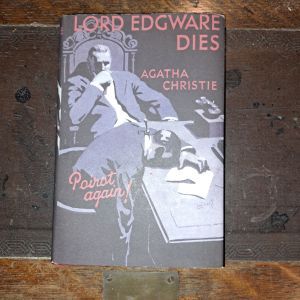 Reading this vintage reproduction makes the mystery all the more evocative of the 1930s (the book was first published in 1933)To continue to read widely, combining favourite authors with new-to-me discoveries, including work by the students of my Simply Self Publish course.My first read of the new year is a handsome retro reproduction edition of
Lord Edgware Dies
by Agatha Christie, after finishing reading Lucy Worsley’s biography Agatha Christie, a Christmas gift from my nephew and his family
Reading this vintage reproduction makes the mystery all the more evocative of the 1930s (the book was first published in 1933)To continue to read widely, combining favourite authors with new-to-me discoveries, including work by the students of my Simply Self Publish course.My first read of the new year is a handsome retro reproduction edition of
Lord Edgware Dies
by Agatha Christie, after finishing reading Lucy Worsley’s biography Agatha Christie, a Christmas gift from my nephew and his familyTravel
I’m planning to combine further trips around the UK catching up with friends and family around the country, including London, Norfolk, Suffolk, Sussex, and ScotlandMy annual trip with my daughter is likely to be either to Scandinavia or Madeira – we’re still decidingThere may be at least one writing retreat coming up – I’m always open to suggestions!Personal
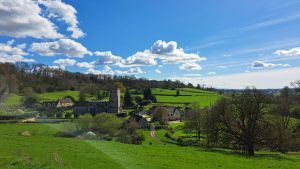 A bird’s-eye view of St Mary’s Hawkesbury and Church Farm House, from the top of Hawkesbury KnollI’m planning to organise regular dates with my family (I’m lucky to have both parents and brother and sister living within easy reach) so that I can manage my work schedule more effectivelyI’m going to leading some of the services at St Mary’s Hawkesbury – I’ve already helped lead two in the run-up to Christmas, and I really enjoyed themWhile fulfilling my commitments to the PCC and the Friends of St Mary’s, I don’t plan to be inveigled onto any more local committees!Take more walks with my siblings and with friends to get me away from my desk for health reasons
A bird’s-eye view of St Mary’s Hawkesbury and Church Farm House, from the top of Hawkesbury KnollI’m planning to organise regular dates with my family (I’m lucky to have both parents and brother and sister living within easy reach) so that I can manage my work schedule more effectivelyI’m going to leading some of the services at St Mary’s Hawkesbury – I’ve already helped lead two in the run-up to Christmas, and I really enjoyed themWhile fulfilling my commitments to the PCC and the Friends of St Mary’s, I don’t plan to be inveigled onto any more local committees!Take more walks with my siblings and with friends to get me away from my desk for health reasonsAll in all, I’m hoping for a busy, productive and enjoyable 2025, with a healthy balance of writing, reading, travel, and time with family, friends and community.
What are you key achievements of 2024 and your goals for 2025? I’d love to hear about your plans too!
December 23, 2024
Hurrah for Bank Holidays!
This may seem odd when I’m self-employed and can choose my own working hours, but I still look forward to bank holidays.
It’s the same as when I was a nine-to-five wage slave. Knowing most of the rest of the world is taking a break allows me to down tools with a clear conscience.
Now that the closure of high street bank branches has forced most of us to bank online, “bank holiday” is a misnomer.
We can bank online 24/7/365. Banking apps are always open for business. The government website still calls them bank holidays, but I think it’s time we changed the terminology.
 The banks I use these days have never had physical branches
The banks I use these days have never had physical branches

“National public holidays” would make sense, as they vary from country to country. Even within the UK, England, Wales, Scotland and Northern Ireland have different holiday calendars. Scotland, for example, takes an extra day off on 2nd January. I’ve always assumed this was to recover from their Hogmanay celebrations. To make up for it, they miss out on Easter Monday.
Such holidays feel all the more important since the 1994 Sunday Trading Act legalised Sunday opening. Now, almost every retailer opens all weekend, and Sunday no longer feels like a universal day of rest.
Even the Outer Hebrides, the last bastion of the Keep Sunday Special campaign, gave way last month. Despite local protests, the Stornoway branch of Tesco started opening seven days a week. (You can read all about it in the Hebrides News here.)
I can think of only one major retailer that hasn’t yet embraced Sunday trading: The Entertainer. On the toyshop chain’s website, founder and director Gary Grant, explains why. “As a Christian, I believe in families. For this reason, our stores are closed on Sundays so our staff can spend quality time with their families.”
What’s more, in the run-up to Christmas, every Entertainer store devotes part of its window space to a traditional Nativity tableau. It’s a refreshing change from the relentless commercialisation of the festive season.
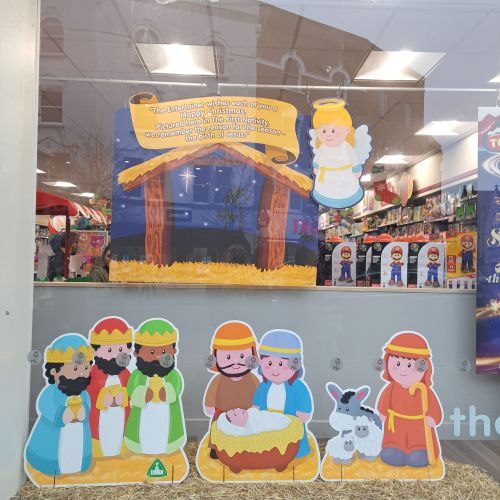 Spotted in the Wimbledon branch of The Entertainer when doing some Christmas shopping earlier this month
Spotted in the Wimbledon branch of The Entertainer when doing some Christmas shopping earlier this monthWhatever your religious views, Grant’s message of “family first” is commendable. Surely the best way to spend a bank holiday is at leisure with family and friends. Restorative time on your own can also a great way to take advantage of these little oases of calm.
As a novelist, I realise how lucky I am to be able to choose my own work schedule. I’m sure I speak for all my readers when I say a special seasonal thank-you to those who selflessly work anti-social hours, providing emergency, essential, and retail services for the rest of us.
However you spend your time this holiday season, I wish you love, joy, and peace, now and throughout the New Year.
This post was originally published in the December 2024/January 2025 edition of the Tetbury Advertiser.
IN OTHER NEWS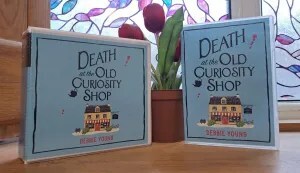 My author copies of the audiobook edition of my latest novel, Death at the Old Curiosity Shop, have just arrived, courtesy of Boldwood Books’ audio partner, Ulverscroft. Although we’re used to digitally streaming audiobooks these days, physical copies like these are invaluable for reaching library borrowers and the visually impaired. I’m so pleased to be able to share my stories in this way.
My author copies of the audiobook edition of my latest novel, Death at the Old Curiosity Shop, have just arrived, courtesy of Boldwood Books’ audio partner, Ulverscroft. Although we’re used to digitally streaming audiobooks these days, physical copies like these are invaluable for reaching library borrowers and the visually impaired. I’m so pleased to be able to share my stories in this way.
UK readers who are members of Amazon Prime may now download the ebook of this novel for no extra charge as part of their Prime membership, between now and the end of February.
Australian readers might like to keep an eye open for some special promotions available in their Amazon store between now and the new year:
Kindle Daily Deals on Murder at the Well on Christmas Day and for its sequel, Springtime for Murder, on 28th December“Today’s Big Deal in Literature and Fiction” for Dastardly Deeds at St Bride’s on New Year’s EveA 12 Days of Kindle promotion for Murder in the Manger between Christmas Day and 5th JanuaryApologies to readers outside of these territories – these promotions are chosen by Amazon, and I have no control over them. I wish they’d offer them to you too!
Meanwhile, my final task before Christmas is to give the final once-over to the proofread manuscript of the next book in my Cotswold Curiosity Shop series, Death at the Village Chess Club, which is due for launch on 3rd March. My publisher, Boldwood Books, has given me a sneak preview of the cover, and it’s gorgeous, clever and bright yellow! I’ll reveal it as soon as it’s official, and I can’t wait to share it with you.
I’m looking forward to a busy and varied year of writing in 2025, and I’ll tell you more about these plans in a special New Year’s Eve post next week.
In the meantime, Merry Christmas!
December 20, 2024
Dreaming of a Green Christmas
In my last column of 2024 for the Hawkesbury Parish News, I’m in the mood for traditional Christmas decorations.
It’s the time of year when sentimental souls start dreaming of a white Christmas, but this festive season I’m focusing on a different colour: green. I’m even drafting this column in green ink.
 I’m gradually building up a holly hedge at the end of my garden – it’s self-seeding (with a little help from berry-eating birds) from the single holly tree that grew there when I moved in
I’m gradually building up a holly hedge at the end of my garden – it’s self-seeding (with a little help from berry-eating birds) from the single holly tree that grew there when I moved inGreen has been the predominant colour of midwinter festivals since pre-Christian times. It’s not just to celebrate Christmas that people have been keen to “deck the halls with boughs of holly” and any evergreens to hand.
Whatever your faith, during the northern hemisphere’s dark winter, bringing evergreens indoors reassures us of the coming of spring, light, and renewed life. That’s a sustaining thought whenever the winter is throwing its worst weather at us.
The Japanese have a word for reaping the benefits of surrounding yourself in greenery. Shinrin-yoku, which translates as “forest bathing”, is all very well if you’re able to get out into a forest. But research proves it’s also uplifting to bring the forest into your home or workplace.
 (Photo by @the829 via morguefile.com)
(Photo by @the829 via morguefile.com)Indoor greenery is thought to:
improve air qualityreduce stressincrease concentration and productivityreduce ambient noisepromote a general sense of well-beingIntroducing these benefits to your home this December can only make your Christmas happier.
 I keep this little bowl of greenery by my desk for some of the benefits mentioned above
I keep this little bowl of greenery by my desk for some of the benefits mentioned aboveEven if you can’t keep house plants alive for five minutes, evergreen branches should stay fresh and keep their colour for at least the twelve days of Christmas. (See Classic FM’s fun post about the meaning of that centuries-old song’s lyrics here .)
 Look out also for Christmas tree festivals near you – my local parish church of St Mary’s Hawkesbury has 17 trees on display, decorated by groups, families and individuals from throughout the community
Look out also for Christmas tree festivals near you – my local parish church of St Mary’s Hawkesbury has 17 trees on display, decorated by groups, families and individuals from throughout the communityCan’t bear harvesting greenery from your garden? Allergic to its distinctive fragrance? Don’t worry. There’s evidence that fake plants offer some of the same benefits.
 I’m very fond of this cascade of fake plants – I’d never remember to water real ones up there
I’m very fond of this cascade of fake plants – I’d never remember to water real ones up thereWorried about the environmental impact of fake plants? BBC Radio 4’s programme Sliced Bread reported on 30th November 2023 (episode still available on BBC Sounds here) that an artificial Christmas tree can be just as environmentally friendly as a real one, provided you reuse it for many years. For maximum benefit, just make sure (to misquote Henry Ford) that your fake tree is any colour you like, as long as it’s green.
Wishing you a very Merry Christmas – and an early arrival of spring!
 To my surprise, this little primrose poked its head above the soil in my front garden a couple of weeks agoIN OTHER NEWS
To my surprise, this little primrose poked its head above the soil in my front garden a couple of weeks agoIN OTHER NEWS I’m delighted to report that my latest novel, Death at the Old Curiosity Shop, is doing well, with over 200 ratings and reviews on Amazon so far, and ranking relatively high in the UK ebook charts. It’s also available in paperback, hardback and audiobook – and you can order it from any bookshop, including high street stores.
I’m delighted to report that my latest novel, Death at the Old Curiosity Shop, is doing well, with over 200 ratings and reviews on Amazon so far, and ranking relatively high in the UK ebook charts. It’s also available in paperback, hardback and audiobook – and you can order it from any bookshop, including high street stores.
The sequel, Death at the Village Chess Club, will be published on 3rd March, and you can already pre-order it in ebook, paperback and hardback. (The audiobook can be ordered from 3rd March onwards.)I’m just checking the proofs before my publisher sends it off for production.
My first task of the new year will be to write the third in the series (as yet untitled). My publisher, Boldwood Books, gave me a sneak preview of the cover for the second book, which I’ll share with you as soon as it’s official.
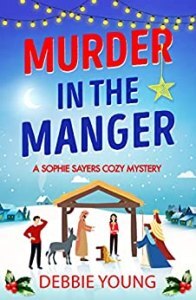 There’s unexpected drama in Sophie Sayers’ Nativity Play in her third adventure, “Murder in the Manger”
There’s unexpected drama in Sophie Sayers’ Nativity Play in her third adventure, “Murder in the Manger”And with my other hand, I’ve been invited to write a Murder Mystery play for the Hawkesbury Drama Group – my first stab at playwriting since I was a child, although I’ve been in quite a few amateur theatre productions since then, including a few Gilbert and Sullivan operettas. You may have already spotted my interest in local amateur dramatics in my Sophie Sayers Village Mysteries. In the first in the series, Best Murder in Show, a member of the Wendlebury Players is a murder victim, and in the third book, Murder in the Manger, Sophie is persuaded to write a Nativity play for the village school – with unexpected consquences!
SIGN UP FOR MY E-NEWSLETTER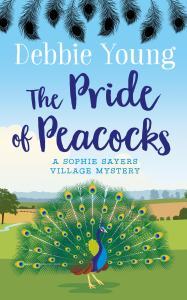 Free novelette in ebook format when you subscribe to my Readers’ Club
Free novelette in ebook format when you subscribe to my Readers’ ClubAnyone who has signed up for my Readers’ Club will receive my newsletter in their inbox whenever I send one. Although I’ve sent very few this year due to pressures of work, my intention is to send them monthly in 2025. Each issue will be a quick read containing the latest news about my books, insights into my writing life, and the chance to enter a free prize draw for a signed hardback or other gift related to my books. Click here to join my Readers’ Club and receive a free novelette ebook, The Pride of Peacocks, as a welcome gift.
SIGN UP FOR MY PUBLISHER’S E-NEWSLETTERMy publisher, Boldwood Books, will also send newsletters about my books, including offers and competitions, once a certain number of readers have signed up for it. I’m teetering on the brink of qualifying, so if you’d like to receive their newsletters – and help me reach my subscriber target! – please click here. Thank you so much!
Both e-newsletters are of course completely free of charge, and you can unsubscribe at any time.
November 30, 2024
In Conversation with Historical Fantasy Author R Marsden
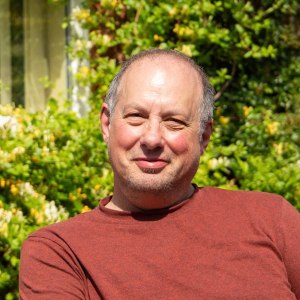 Meet Rory Marsden, who writes historical fantasy novels as R Marsden
Meet Rory Marsden, who writes historical fantasy novels as R MarsdenAs regular readers of my blog will know, I end each month in conversation with an author friend whose work and writing life I think will interest my readers too – even though they may be writing in a completely different genre to my cosy mysteries and other ficiton. To round off November, I’m delighted to welcome my friend and former student Rory Marsden, who writes as R Marsden, and shares news of his books and his writing life at his website www.talesofcastlerory.co.uk.
I first met Rory through the Simply Self Publish course that I teach online for Jericho Writers. A condition for enrollment on the course is that students have at least one publish-ready novel to which they can apply what they learn on my course. Rory immediately impressed me by having not only several novels ready to go, but also a masterplan for a series of 36!
I don’t often read medieval historical fantasy, and I didn’t really have anything in my recent reading to compare it to, so I asked my friend Helen Hollick, a highly successful and experienced author of historical fantasy and historical fiction, what she thought of it. Here’s an extract from her enthusiastic endorsement of the first in series, The Box of Death:
The first in the series
R Marsden’s imagination is immense, with detail of everyday life, weaponry, battles and such included to create a plausible other world where fiction is so entirely suspended that you forget this isn’t a real place, real people or real events.
For reasons that will become clear in our conversation below, I’ve become hooked on Rory’s, which starts with The Box of Death. (I love his titles too – they always intrigue me.) When I started writing my Sophie Sayers cosy mysteries, I had a grand plan of writing a seven-book series, for which I chose the titles before I started writing. So although we’re writing in different genres, I detected a kindred spirit.
Rory was quick to start publishing his books, and I’ve been following them ever since, as rattling good adventure stories with flawed yet likeable characters, plenty of twists and turns, and fascinating depiction of medieval life which never feels like a history lesson.
Debbie: Before we go any further, Rory, please tell us more about your background before you started publishing your books
Rory: I grew up in a London suburb, but I’m a country boy at heart, so my partner and I moved to Norfolk, where I’d spent many idyllic family holidays as a child. Here, we brought up two wonderful children and a border collie, sailing on the rivers and broads of this amazing part of England. My children had a true Swallows-and-Amazons childhood! They had music as well, since I’m both a musician and a scientist.
At school, I loved English, history, music, French, German, biology and chemistry. I wasn’t much good at sport, and I was hopeless at art! After school, I did a degree in biochemistry at University College, London and was engaged for a while in some cutting-edge research in the field of genetics.
For personal reasons, I left my research work and trained as a teacher. For a long time I was a class teacher in my village primary school, which meant everyone in the village knew my name! After many years, I left classroom work to teach piano and electronic keyboard in my home.
I love being self-employed, and this feeling of being my own boss is probably the reason I chose to publish my books myself rather than seek a traditional publishing deal.
I am the organist in my parish church, and this means a lot to me. I still teach piano and keyboard to my lovely pupils, both children and adults, and I enjoy being involved in medieval events around the country. I’ve taught myself to play the gittern (an early form of guitar) and I have a replica fourteenth-century recorder, which is also great fun to play. When I perform in medieval fayres, I attach jingles to my ankles, I have a drum I can tap with my foot and I play recorder or gittern at the same time! Takes a bit of practice!
Debbie: Gosh, I never knew you were a scientist too, Rory – you’re truly multi-talented! Now, can you please share a brief description of the concept behind your series.
Rory: I wrote The Box of Death around the title. The title just came into my head, and I wrote a book that incorporated it. But before that, I knew I needed to write a book set in the Middle Ages, and that was because of my AirBnB room! After much deliberation, I’d decided to call my guest accommodation “The Buttery”, but it was only after that decision was made that I found out what a “buttery” actually was – a service room in a medieval castle. So I remodelled my house on such a castle. Obviously. And that castle needed a context, a story behind it. That was the inspiration for the book, while the title, as I said, just happened along.
Having finished The Box of Death, I kind of wanted to know what happened next. I left Lord Rory pretty despondent in his lonely library, wondering if the last fifteen years of his life had been the triumph he’d always assumed. Deciding that no, actually he’d made many bad mistakes. The book closes with a air of gloom, and I didn’t want to leave it like that. I’d also given Rory a younger brother, and, simply to account for his absence from the castle, I’d made him a mercenary soldier, fighting battles for other people somewhere in Europe. So, in Book Two, The Soldier of Fortune, I explored Nicholas a lot more, and I found him to be an interesting character in his own right.
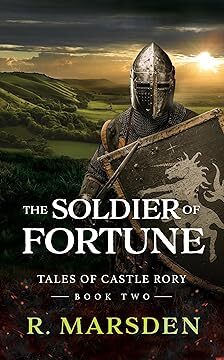 Book 2
Book 2And so the series grew organically, with no plan (at least at first) and no particular concept (at least at first). Book Three, The Man in the Moon, also grew from the title. I just liked the idea of writing a book with that title!
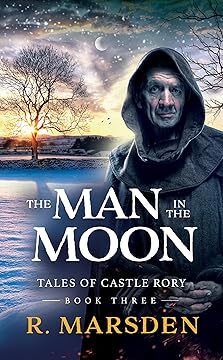 Book 3
Book 3The series concept is a lot clearer now, and, in fact, I know exactly where it’s going. But it’s taken six years to find out!
Debbie: I mentioned earlier that b efore you published the first book, you had a grand plan that the series would run to 36 books. Why 36?
Rory: This is a great question, because it follows directly from my previous answer! Once I knew the series concept, I knew how it was going to end. The series, Tales of Castle Rory, is a set of secret journals which Lord Rory of Hambrig writes. In each Tale he notes down his hope that one day, “maybe a long time from now”, someone will read his journal and will understand “how and why we did what we did”.
I love this idea – that someone is writing a diary for future generations to understand a time before their own.
Debbie: As a reader, I think it works really well – and it adds further excitement to his adventures that he seems to be recording them as they happen.
Rory: This hope, or dream as he calls it, is stated in every one of the Tales, each of which is approximately a year of Lord Rory’s life, although he’s already 33 when he begins writing. So I had to work out the year of his death, since that would clearly mark the end of the Tales. Once I knew that, I had the exact number of books needed to complete the series.
Which turned out not to be true! Sometimes a Tale spans more than a year, since the Epilogue may take place a year or so after the end of the main narrative. So I have hazarded 36 books, but until I get close to the end of Lord Rory’s life, I won’t know exactly.
I would like to add that, although so far I’ve written the first seven books out of a possible 36(!), I have also written the final book. This book does not chronicle Lord Rory’s death, as you might expect, nor is it his final Tale with the last journal entry an unfinished sentence with ink desperately trailing down the page. Instead, it’s a novel set in the year 2022, and it’s called The End of Time. Here, then, is Lord Rory’s dream finally fulfilled.
Debbie: Wow! I’ll look forward to finding out what that’s all about! So, must the books be read in order of publication or do they work as standalone novels too?
Rory: Of course you can start anywhere, but it makes a lot more sense if you read from the beginning. I remember picking up one of C J Sansom’s Shardlake series and loving it. I found out it was Book Three, so I went back to the beginning and read the series in order. But the Shardlake books don’t rely on many previous characters reappearing in each book, and my Tales of Castle Rory assume you know not only the characters, but their relationships with each other, from previous books. So start at the start!
Debbie: We should mention there’s also a free prequel available to anyone who joins your mailing list, set during the Crusades. For our readers’ benefit, please explain how the prequel relates to the rest of the series.
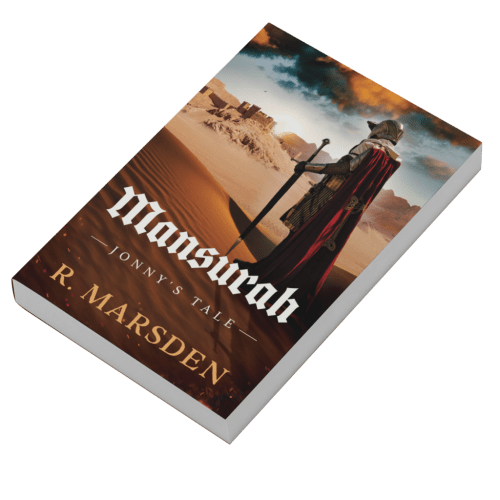 This is the free prequel you can download when you join his Household News mailing list via his website
This is the free prequel you can download when you join his Household News mailing list via his websiteRory: In his journals, Lord Rory often refers to his time on the Seventh Crusade. This period of his life, approximately five years, forged him as a man, brought him friendship with Jonny and allowed him to grieve for Kathryn.
It gave him skills and values that he draws on throughout his life.
After I’d written several of the main books, I knew I needed to find out more about Rory’s adventures on Crusade, and this was roughly the time I found out about “reader magnets” – free books for subscribers to an author’s mailing list. I set up my newsletter, which I call “The Household News” (I picture it as a parchment scroll, pinned to the door of the great hall by Sir Patrick, the castle steward, informing the household of everything that’s happening), and I decided that my “reader magnet” would be the story of Rory as a Crusader.
And then I made the decision to tell it from Jonny’s point of view. I felt it would be good for me, as an author, to explore my main protagonist from the outside. Because the main books are Rory’s journal, they’re obviously written in the first person, and everything is told as he sees it. This shorter book (it’s a novella) gave me the chance to use Jonny’s voice instead. I think it reads very differently from the Rory-point-of-view books.
I assumed that anyone reading the prequel, called Mansurah: Jonny’s Tale had already read The Box of Death. So they would know who Rory and Jonny were, and would be able to put the Crusader story in context as a prequel. But it is also a standalone novella, assuming no previous engagement with the characters.
Debbie: I actually started by reading the prequel, which really whetted my appetite for the first book in the series proper, and the transition from novella to novel, and the change of perspective, worked very well for me. Now, 36 books equates to a lot of adventures! How will you make adventure different and distinctive, and how much will be fantasy and how much historical realism?
Rory: My books are character-driven, so it’s the development of Lord Rory, Jonny, Kit, Patrick and the others that makes each Tale different. Rory’s difficulties with women, the breakdown of his friendship with Jonny, his admiration for Kit, his dependence on Patrick and his fear of failure all make each adventure different, as these problems or tendencies increase and decrease according to events.
Before starting a new book, I research the historical events during the year in which the book is to be set.
These, if at all possible, are then incorporated into the story and form the backdrop. So The King’s Ransom, set in 1265-66, has the formation of the Hanseatic League as its backdrop. Although the main story is about Rory’s marriage to the daughter of the King of Smander, this very connection has been set up by the King of Mallrovia, who is desperate for Hambrig to be accepted into the new trading league. Everything, therefore, revolves around this.
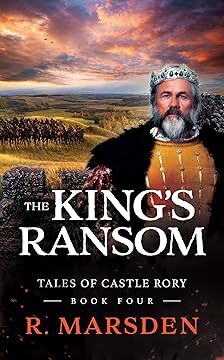 Fourth book
Fourth bookSimilarly The Soldier of Fortune takes place in 1264, the year of the Battle of Lewes during the Second Barons’ War in England. Rory and his companions end up taking part in this battle and being drawn into the ideas of democracy, parliament and elected representatives.
Fantasy creeps into each book (because I love it!), but it’s more obvious in some than in others.
It’s almost always based in fact, which seems a contradiction in terms, but Jabir’s alchemical laboratory is based on real discoveries, the use of hallucinogenic drugs (especially in the Middle East) is well documented from this time, and the binding of magic to religion was an accepted construct of the time.
The only “true” fantasy, i.e. not based on primary source evidence, is Kit’s knowledge of the future. This allows me to have more flexibility in the story arc and, I hope, to tantalise the reader.
Debbie: Yes, those little hints from Kit work very well! So, as you introduce new characters and settings in each story, how do you keep track of them along the way?
Rory: I have two spreadsheets, one called TOCR People, the other TOCR places (TOCR = Tales of Castle Rory). The People list gives me names, dates of birth/death, relationships, and if they are historical or my own characters. The Places spreadsheet details all places, both geographical and fictitious, and I have also calculated distances between them and how long it would take to walk, ride, or travel by horse and cart.
Debbie: Gosh, I wish I was that organised with my characters and settings! I need to learn to love spreadsheets!
Rory: Also, this year, I discovered AI! This has been fantastic for my characters.
I use AI to show me what each person looks like at different stages of their life, by telling it the main features, social status and setting.
I love having these pictures to work with, they really help me “see” my characters.
I’m also indebted to my illustrator, Ian R. Ward, who drew the map of Mallrovia and the plan of the castle. These are included at the start of each book, and they’re also on my website. I’d be pretty lost without them!
Debbie: Yes, the illustrations are really atmospheric as well as helpful. Now for the question that readers have probably been wondering since the start of our chat! Your protagonist shares your name. To what extent are his adventures your wish fulfilment?
Rory: I love this question, and thank you for asking it! My books were not written for publication. Not when I wrote the first two or three, anyway.
They were written for my family, and most of all for me to share with my mum, who was also an author.
She had helped me choose my Airbnb name (“The Buttery”), and she encouraged my writing and loved my stories. Her name was Joan, and, in the Tales, Joan is Rory’s best friend. Rory always says that Jonny is his best friend, but in reality it’s Joan. The books, therefore, were not for others to read, in the same way that Lord Rory doesn’t want his journals read by his contemporaries.
My mum died last year, and my books are published in honour of her. She wanted me to publish them, but I always said they were just “for us”. Now there’s no longer an “us”, and I have done what she always wanted.
Debbie: That’s so lovely, Rory. I bet she’d be really pleased and proud. So if Lady Joan is a tribute to your mum, is Lord Rory really your alter ego?
Rory: Yes, in many ways, Lord Rory is my alter ego. But what is less obvious is that Nicholas and Tamsin (Lord Rory’s brother and sister) are also my alter egos.
My writing is not an exercise in self-exploration, although it may sound like it from the above, and in fact I didn’t even realise much of this myself until I was part way through Book Three.
Surely, though, all authors put themselves into their books? Not overtly, or explicitly, but to some extent at least? Clearly, it is more overt in my books, since my hero has my own name, but, as I’ve said, that’s purely because when I began the series it was never going to be seen by anyone other than my mum. And, because of the way it grew, because of this idea I had to honour her in this way, I had no desire to change my characters’ names even after making my decision to publish. And this is why my author name is R. Marsden.
Debbie: I completely agree, Rory! Whether or not we do it consciously and intentionally, we can’t help but draw on our own experiences and characters. One of my longest-standing friends, whom I’ve known since I was 11, said to me once, “Sophie Sayers, she’s just you, really, isn’t she?” Although I’m old enough to be Sophie Sayers mum, and, at a stretch, even her grandmother, and she’s quite a dippy characters in some ways, I decided to take that as a compliment!
But at least with Sophie Sayers I’m writing a contemporary story, set in a village inspired by the one I’ve lived in for most of my adult life, so I don’t have to do much research. In fact, villagers approach me with story ideas now – at bell ringing practice, my fellow bell ringers keep telling me new and different ways to murder someone with a bell! Whereas your books have a sound foundation of historical fact. To write such a long series requires a huge amount of factual historical knowledge. How do you research your books?
Rory: I do a great deal of research, both before I begin writing a book and during the course of creating the first draft. I love the British Library’s collection of digitised manuscripts and have made great use of these as primary sources. I also have a large collection of books, and have made particular use of the ones by Joseph and Frances Gies, a lovely collection of books on medieval life. I have books on swords, daggers and shields, books on heraldry and many books on medieval combat and warfare. I have drawn on these extensively, as well as many articles on the internet.
But it’s the primary sources I always locate first. It takes a great deal of time, but it’s so enjoyable, and so essential, I don’t mind doing it at all.
Debbie: Tales of Castle Rory are set largely in territory is now East Anglia. How much of East Anglia’s history, geography and culture are embedded in your books?
Rory: My kingdom of Mallrovia equates to the county of Norfolk (where I live), and the principality to the south, Westador, equates to the county of Suffolk. The history, geography and culture of Mallrovia and Westador bear no resemblance to those of Norfolk and Suffolk, with the exception of one aspect only: I have transcribed the Norfolk accent to be the Hambrig dialect in my books. I like to think Norfolk people would recognise this! But this is my only reference to these genuine counties; in all other respects there is no equivalence.
Debbie: Now for a more general question. Who are your favourite authors in your genre and why?
Rory: I have always struggled to know which genre I write in. On the face of it, it’s medieval fantasy, but in most people’s minds this means dragons, wizards, strange beasts or alternative universes. My books have none of these tropes.
My fantasy is different, and my books are grounded in real historical events, and also – apart from my fictitious countries of Mallrovia, Westador and Smander – real geographical places.
However, I have just read one of Robin Hobb’s books, and her genre is pretty close to mine – what I believe is termed “genre-adjacent”. In historical fiction, I love reading Ken Follett, C.J. Sansom and Anne O’Brien.
Debbie: Here’s another way of defining your genre: how should readers feel after reading one of Lord Rory’s adventures?
Rory: My hope is that readers feel empathy with the characters.
I’ve tried to make them three-dimensional, so nobody is utterly heroic and nobody is unrelentingly evil.
I would love it if readers sympathise with the dilemmas Lord Rory wrestles with, especially his own demons. As I’ve said already, each “adventure” is really a vehicle for character expression and development. So hopefully it’s the people who stay in the mind, rather than all the shenanigans!
Debbie: What inspired you to write about this particular era and this particular region?
Rory: Well, as you know it all came from naming my airbnb room “The Buttery”. However, originally, I was going to have the action set a hundred years later, so fourteenth rather than thirteenth century. But I’d set my heart on the hero having been a Knight-Crusader, so when I found the Crusades were all over by 1272, I had to move the action back a hundred years.
As for the region – this was such a personal project, it needed to be based where I am. Making Norfolk into a sovereign state was a lot of fun and gave me a huge amount of leeway to have places where I wanted them and create hills, rivers, uplands and lowlands wherever I chose. Once Ian Ward had drawn the map, it all became very real, and I could picture the travellers as they move from place to place. The place names are my own invention, and there’s a good reason for all of them, but you’ll have to read the final book to know what that is!
Debbie: Gosh, that’s tantalising! Another practical question now: you’ve come to writing fiction at a relatively mature age. When did you first conjure up Lord Rory’s world?
Rory: The world built itself, bit by bit. The castle was always there, and I placed it high on a hill with a treacherous river at the bottom. I began writing in December 2018, and it’s been an organic process, growing and developing slowly over the last six years. I had no idea when I started where it was all leading. Now it’s exciting to wonder what direction it will take as I move inexorably towards The End of Time.
Debbie: Even for someone as industrious and prolific as you, writing 36 books is a tall order. Do you have any other writing ambitions?
Rory: No. It will be enough for me to complete this series, and I’m so immersed in the World of Hambrig, it would be hard to emerge from it and enter some new sphere. Tales of Castle Rory isn’t my first writing project though.
Years ago I wrote a trilogy about a teenage boy encountering a crime scene. It was told from the point of view of his dog. I enjoyed writing it at the time, but I haven’t read it since. Before that, when my children were young, I was always writing stories for them, and composing songs as well.I’ve been a creative writer and composer all my life.
Debbie: Rory, thank you so much for sharing these insights into your fabulous series today. I’ll pop useful links below for anyone who’d like to try your stories for themselves, whether the free novella available when they sign up for your newsletter, or the five books published so far. Now I’m off to catch up with books 4 and 5 – The King’s Ransom and Paradise Garden, in hope of catching up with you before your publish book 6!
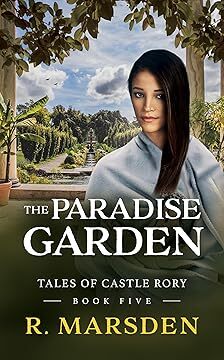 Book 5FOR MORE INFORMATION ABOUT R MARSDEN AND HIS HISTORICAL FANTASY BOOKS
Book 5FOR MORE INFORMATION ABOUT R MARSDEN AND HIS HISTORICAL FANTASY BOOKS Tales of Castle Rory website: www.talesofcastlerory.co.uk
Tales of Castle Rory website: www.talesofcastlerory.co.uk
(where you can download the free prequel novella, Mansurah: Jonny’s Tale, when you sign up for Rory’s Household News newsletter)
Order the novels as paperback and ebook for Kindle via Amazon worldwide here.
(If you subscribe to Kindle Unlimited, you can read all his novels at no extra cost as part of your monthly subscription.)
Another good way to catch up with Rory’s books is to download the first three novels as a box set of ebooks for Kindle.



